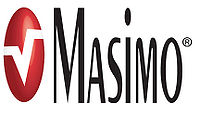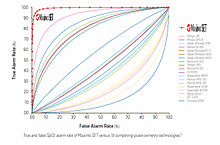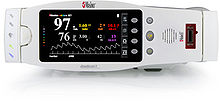- Masimo
-
Masimo Corporation 
Type Public (NASDAQ: MASI Industry Medical technology
Medical monitorsFounder(s) Joe E. Kiani Headquarters Irvine, California, United States Area served Worldwide Revenue US$ 405 million[1] Employees 2,000 (2010) Website masimo.com Masimo Corporation is an Irvine, California-based manufacturer of non-invasive patient monitoring technologies.[2] The company is best known for its pulse oximetry and it sells more pulse oximeters than any other company.[3] Masimo was founded in 1989 by electrical engineer Joe E. Kiani, who was later joined by fellow engineer Mohamed Diab.[4] Masimo invented measure-through motion and low perfusion pulse oximetry, known as Masimo SET (Signal Extraction Technology). Masimo has been recognized for its intellectual property and for being one of the most innovative companies in the medical device industry.[5] The company went public in 2007 [6] and is currently traded on the NASDAQ stock exchange under the symbol MASI. In 2011, Forbes named Masimo to its list of top 20 public companies under a billion dollars in revenue, based on earnings growth, sales growth, and return on equity.[7][8]
Contents
Masimo SET Pulse Oximetry
Conventional pulse oximetry assumes that arterial blood is the only blood moving (pulsating) in the measurement site. However, during patient motion, the venous blood also moves, which can cause conventional pulse oximetry to under-read arterial oxygen saturation levels because it cannot distinguish between the arterial and venous blood.[9][10] Masimo SET signal processing identifies the venous blood signal (which has a lower oxygen saturation level than arterial blood), isolates it, and uses adaptive filters to cancel the noise and extract the arterial signal in order to report accurate arterial oxygen saturation and pulse rate. Multiple studies have shown that Masimo SET increases pulse oximetry's ability to detect life threatening events and reduce false alarms.[11][12] Additional studies have also shown the impact of Masimo SET on patient outcomes, such as helping clinicians detect congenital heart disease in newborns and reduce retinopathy of prematurity in premature infants.[13][14]
Rainbow Pulse CO-Oximetry
Rainbow Pulse CO-Oximetery continuously and non-invasively measures hemoglobin (SpHb), carboxyhemoglobin (SpCO), methemoglobin (SpMet), and pleth variability index (PVI), in addition to oxyhemoglobin (SpO2), perfusion index (PI) and pulse rate.[15] A study at Massachusetts General Hospital showed that SpHb monitoring helped clinicians decrease the frequency of patients receiving blood transfusions during surgery from 4.5% to 0.6%.[16] An emergency department study showed that SpCO increased the detection of carbon monoxide poisoning.[17] Another study showed that PVI monitoring helped clinicians decrease fluid administered during surgery and reduce patient risk.[18]
The World Health Organization called Masimo's Pronto-7 non-invasive hemoglobin spot-check device an “innovative medical technology for cost-effectively addressing global health concerns and needs”[19] and the device has been recognized with a gold Medical Design Excellence Award [20] In December 2010, Masimo announced a voluntary recall of the Pronto-7 to address a design issue related to inaccurate readings in certain conditions.[21]
SafetyNet
Masimo SafetyNet is a remote monitoring and notification system designed for patients on general care floors.[22] A large study by Dartmouth-Hitchcock Medical Center showed SafetyNet helped clinicians achieve a 65% reduction in distress codes and rescue activations and a 48% decrease in patient transfers to intensive care units, yielding a savings of 163 ICU days annually.[23] ECRI Institute gave Dartmouth its Health Devices Achievement Award for its use of SafetyNet to prevent "severe patient harm".[24] Masimo recently debuted Halo Index in the SafetyNet system, combining multiple physiologic parameters into one number to help clinicians assess overall patient status.[25]
Rainbow Acoustic Monitoring
Rainbow Acoustic Monitoring provides non-invasive and continuous measurement of respiration rate using an adhesive sensor with an integrated acoustic transducer that is applied to the patient's neck.[26][27] Researchers have evaluated acoustic respiration rate (RRa) and found the acceptable accuracy and significantly fewer false alarms than traditional respiration rate monitoring methods, end-tidal carbon dioxide (EtCO2) and impedance pneumography.[28]
 True and false SpO2 alarm rate of Masimo SET versus 19 competing pulse oximetry technologies [12]
True and false SpO2 alarm rate of Masimo SET versus 19 competing pulse oximetry technologies [12]
References
- ^ http://www.sec.gov/Archives/edgar/data/937556/000119312511036970/d10k.htm
- ^ http://finance.google.com/finance?q=NASDAQ:MASI
- ^ http://www.marketresearch.com/vendors/viewVendor.asp?VendorID=3689
- ^ http://www.ocbj.com/news/2006/mar/20/masimos-kiani-stared-down-tyco/
- ^ http://www.medicalnewstoday.com/articles/46369.php
- ^ http://www.nasdaq.com/reference/200808/market_open_080708.stm
- ^ http://www.forbes.com/sites/kurtbadenhausen/2011/10/19/the-top-20-small-public-companies-in-america/
- ^ http://www.forbes.com/pictures/mli45gdjh/19-masimo
- ^ Mardirossian, George; Schneider, Ronald E. (1992). "Limitations of pulse oximetry". Anesthesia Progress 39 (6): 194–6. PMC 2148612. PMID 8250340. http://www.pubmedcentral.nih.gov/articlerender.fcgi?tool=pmcentrez&artid=2148612.
- ^ Barker, SJ; Tremper, KK (1987). "Pulse oximetry: Applications and limitations". International anesthesiology clinics 25 (3): 155–75. doi:10.1097/00004311-198702530-00010. PMID 3323062.
- ^ Malviya, S; Reynolds, PI; Voepel-Lewis, T; Siewert, M; Watson, D; Tait, AR; Tremper, K (2000). "False alarms and sensitivity of conventional pulse oximetry versus the Masimo SET technology in the pediatric postanesthesia care unit". Anesthesia and analgesia 90 (6): 1336–40. doi:10.1097/00000539-200006000-00013. PMID 10825316.
- ^ a b http://www.ncbi.nlm.nih.gov/pubmed?term=barker%202002%20pulse%20oximetry%20masimo
- ^ De-Wahl Granelli, A.; Wennergren, M.; Sandberg, K.; Mellander, M.; Bejlum, C.; Inganas, L.; Eriksson, M.; Segerdahl, N. et al. (2009). "Impact of pulse oximetry screening on the detection of duct dependent congenital heart disease: A Swedish prospective screening study in 39 821 newborns". BMJ 338: a3037–a3037. doi:10.1136/bmj.a3037.
- ^ Castillo, Armando; Deulofeut, Richard; Critz, Ann; Sola, Augusto (2011). "Prevention of retinopathy of prematurity in preterm infants through changes in clinical practice and SpO2 technology". Acta Paediatrica 100 (2): 188–192. doi:10.1111/j.1651-2227.2010.02001.x. PMC 3040295. PMID 20825604. http://www.pubmedcentral.nih.gov/articlerender.fcgi?tool=pmcentrez&artid=3040295.
- ^ http://www.medicalnewstoday.com/articles/59424.php
- ^ http://www.anesthesiologynews.com/ViewArticle.aspx?d=PRN&d_id=21&i=November+2010&i_id=679&a_id=16133
- ^ Suner, S; Partridge, R; Sucov, A; Valente, J; Chee, K; Hughes, A; Jay, G (2008). "Non-invasive pulse CO-oximetry screening in the emergency department identifies occult carbon monoxide toxicity". The Journal of emergency medicine 34 (4): 441–50. doi:10.1016/j.jemermed.2007.12.004. PMID 18226877.
- ^ Forget, Patrice; Lois, Fernande; De Kock, Marc (2010). "Goal-Directed Fluid Management Based on the Pulse Oximeter–Derived Pleth Variability Index Reduces Lactate Levels and Improves Fluid Management". Anesthesia & Analgesia: 1. doi:10.1213/ANE.0b013e3181eb624f.
- ^ http://www.healthcarereview.com/2010/08/noninvasive-hemoglobin-test-first-ouchless-bloodless-makes-world-health-organizations-who-list-of-innovative-medical-technologies-that-address-global-health-concerns-and-needs/
- ^ http://www.canontradeshows.com/expo/awards/awards/index.php?catId=-1&year=2011&view=View
- ^ "UPDATE 1-Masimo says to recall sensors used in hemoglobin tester". Reuters. 22 December 2010. http://www.reuters.com/article/2010/12/22/masimo-idUSSGE6BL0AE20101222.
- ^ http://medgadget.com/archives/2007/10/masimo_patient_safetynet.html
- ^ http://dms.dartmouth.edu/news/2010/03/05_taenzer.shtml
- ^ https://www.ecri.org/Press/Pages/Health_Devices_Award_Winner_2009.aspx
- ^ http://www.medgadget.com/archives/2010/10/masimo_to_release_new_halo_index_radical_7_pulse_oximeter_patient_safetynet_monitoring_system.html
- ^ http://www.rtmagazine.com/news/2009-12-01_01.asp
- ^ http://www.asaabstracts.com/strands/asaabstracts/abstract.htm;jsessionid=ED84A8C2F2FA0F72B892E720DA7F87A2?year=2010&index=15&absnum=1947
- ^ Goudra B., Penugonda L. "Monitoring Respiration in Upper GI Endoscopy Anesthesia" ASA 2011 Presentation A246.
External links
Categories:- Companies listed on NASDAQ
- Medical monitor
Wikimedia Foundation. 2010.




